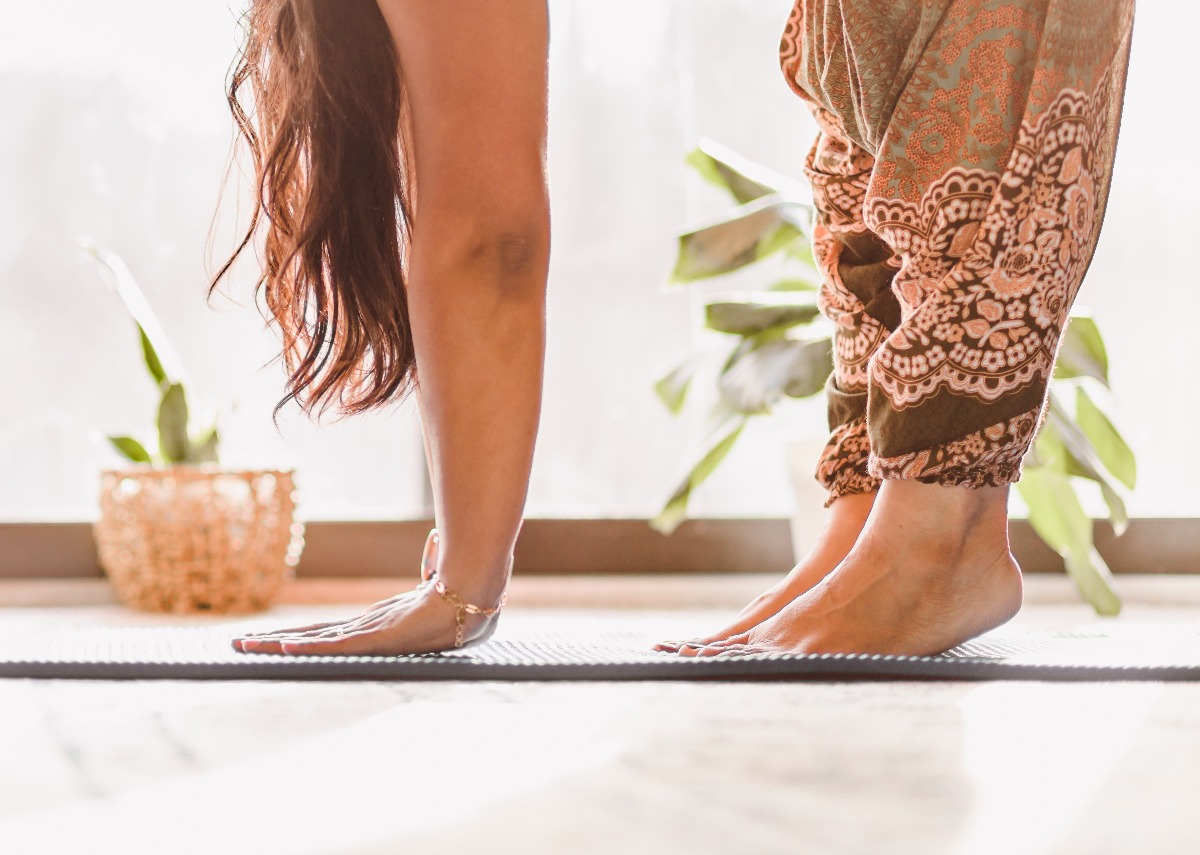Yoga and Pilates postures often involve the wrists. I consult clients with painful wrists in my beyogalates, yoga and pilates classes regularly at my physiotherapy practice. One of the most common yoga and Pilates injuries complained about by beginner and advanced yogalates students alike is wrist pain. It’s pretty understandable when you think about it, since you’re frequently bearing weight on your hands during your time on the mat, which isn’t something you typically do in everyday life.
There are so many yoga and pilates poses that require your hands to be on the ground four point kneeling, cat-cow, tabletop, downward dog, upward dog, plank, side plank, mountain climbers, arm balances, handstand, etc.), and repeating these postures over and over with poor wrist and hand positioning can lead to injury.
Before resuming the poses that require 90 degrees of extension—or before embarking on them, if you’re beginning yogalates—it’s a good idea to check the range of extension of your wrists. You can do this by coming to your hands and knees with the heels of your hands directly under your shoulders. Your wrists are now at 90 degrees of extension. Are they completely comfortable in this position? If not, you should work to gently and gradually increase your wrist extension.
Tips to maintain good wrist health
I’d like to share some tips and strategies I use with my yogalates clients and physiotherapy clients;
Start gradually;
When beginning yogalates, students and anyone with wrist injuries or problems begin weight bearing on their arms slowly. Rather than suddenly launching into dozens of down face dog poses start by spending a little time almost every day on your hands and knees ( on all fours) …
In this position, there is relatively little weight on the hands, so the wrists can become accustomed to weight bearing.
Limit wrist extension;
On you’re hands and knees, you can also vary the degree of extension of your wrists. If placing the heels of your hands directly below your shoulders feels too intense, you can move your hands out a little in front of your shoulders, reducing the amount of extension.
Prop your palms;
Reducing the angle between your forearm and your hand can take some pressure off of the wrists. Place a wedge, a folded towel, or a folded blanket toward the top of your mat and use it throughout your entire Yoga or Pilates practice…with the base of your palms on the thickest part. Let your fingers touch the mat, and don’t forget to spread them wide here as well.
Using a rolled-up sticky mat or a foam or wood wedge under the heels of the hands similarly reduces the sharp angle of extension of the wrist in Plank Pose and arm weight bearing exercises
Distribute the weight;
Be mindful to evenly distribute the weight in your palms spread out your fingers and keep them inline with your wrist.
Spread your fingers: Everyone should be doing this, regardless of wrist injury. Practice this in tabletop. Bring your shoulders directly over your wrists and your hips directly over your knees. Take a look at your hands. Spread your fingers as wide as you possibly can. Maintain that spread as you press down evenly into all of the knuckles, the fingertips, and all four corners of the palm.
Often people inadvertently put too much weight on their wrists; that is why they tend to dump their body weight on the base of their hands, accidentally straining their wrists. Instead, you should be supporting your body with your fingers and the base of your fingers. Yoga instructors call this practice Hasta Bandha or “hand lock.”
Make fists;
This works particularly well for tabletop and plank positions. Come to tabletop and make a fist (with your thumb outside of your fingers) and place the flat expanse of your knuckles on the floor. Activate the muscles in your forearm and practice stepping into and out of plank from tabletop, being careful as not to allow your wrists to buckle inward or outward. If this buckling occurs, skip this modification.
Use your forearms;
When others are practicing poses (like plank, side plank, and handstand) that can aggravate your wrist injury, use your forearms instead!
Modify plank with forearm plank
Modify side plank with forearm side plank
Modify handstand with forearm stand
Create scaffolding;
Use your shoulder and core stability muscles to avoid collapsing into your wrists. Imagine your are pushing the mat away, lightly lifting out of you shoulders and setting scapula ( shoulder blades) onto your back. Switch on your core. This all acts as scaffolding to support you!
Start with a prop;
If you are weak not just in your wrists but also in your arms and shoulders, you may find it helpful to begin with modified versions of Downward Dog and Plank using a chair. Pick an armless chair with a firm seat. Put a folded sticky mat over the seat to lightly pad the heels of your hands. Then place your hands on the seat with the fingers pointing out to the sides instead of forward and wrap the fingers around the sides of the seat. Walk your feet back until your body forms a straight line from heel to hip to shoulder to ear, and you will be in the modified Plank Pose.
Take a child’s pose;
When in doubt, skip it! There are certain poses that just don’t work during times of injury. Perhaps, the best modification for a pose that puts a great amount of pressure on your wrists is a simple child’s pose.
All of this basically translates to less pressure on your knees and wrists and a happier, pain-free yogalates practice in the long run.
If you are already experiencing wrist pain during your yoga practice it’s important to evaluate all aspects of your life to see what may be contributing to the wrist pain. Most likely, it’s not just yoga. Do you type all day? Work at a manual labor job that puts strain on your wrists? What other repetitive motions may be contributing to wrist pain? You may have a sprain or strain, a repetitive motion injury or a condition like carpal tunnel syndrome.
Consult your physiotherapist if pain persist and be sure to watch the safety tips video on my Beyogalates workout page.
See you on the mat.
Lisa x

